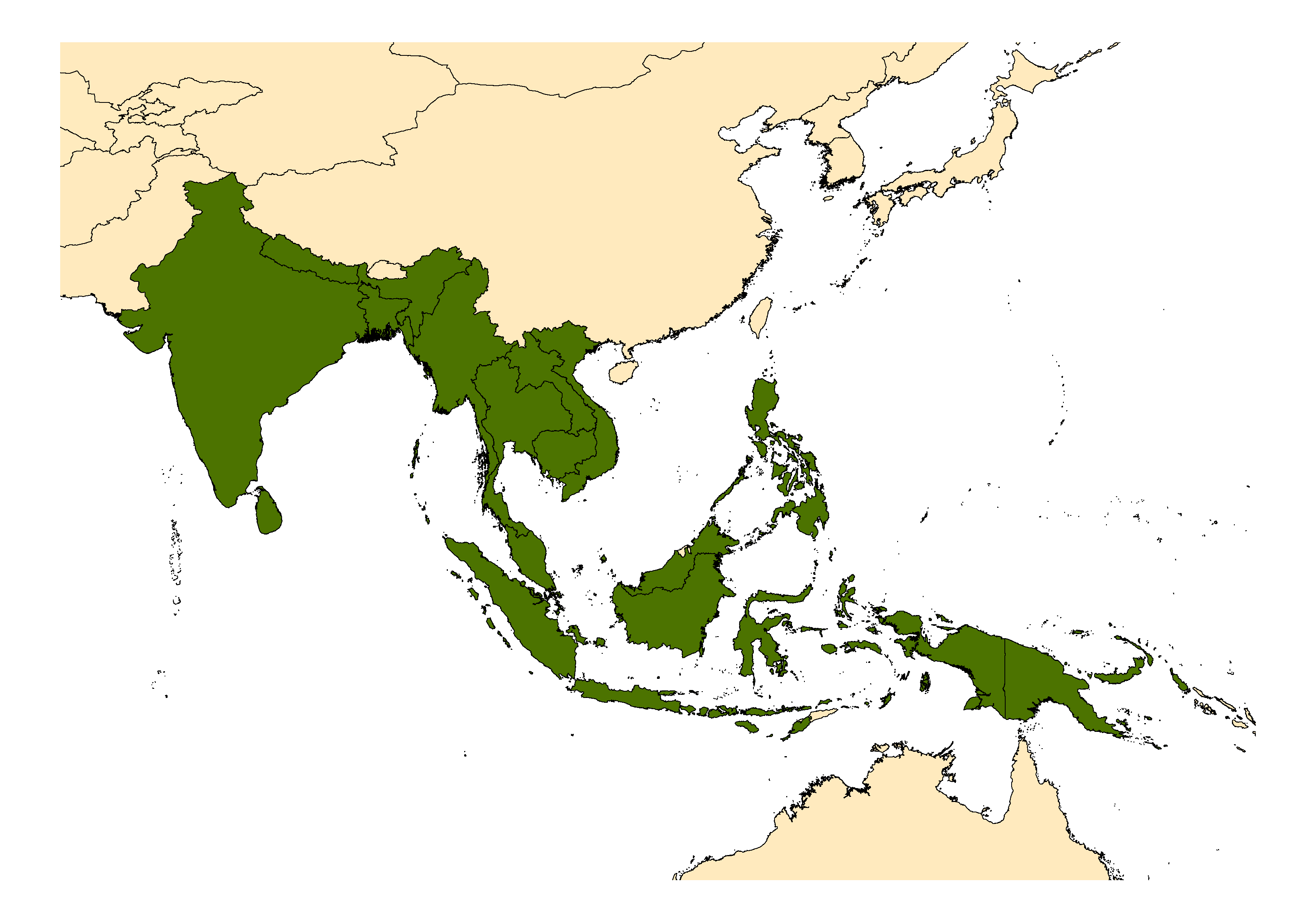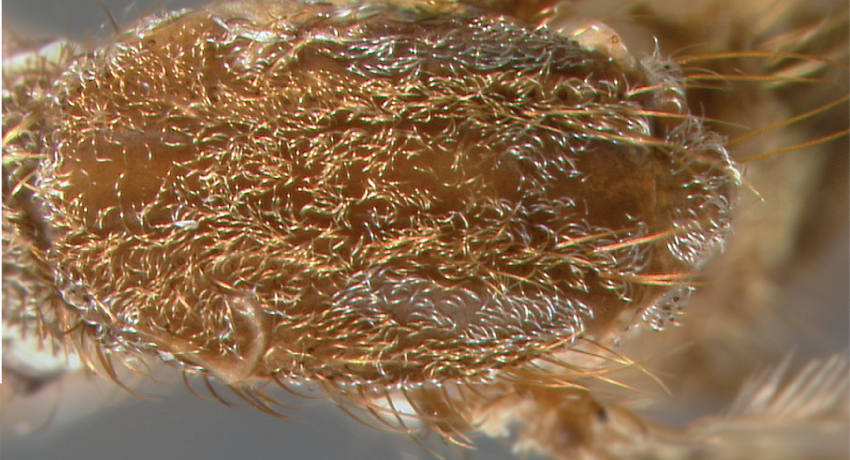AUSTRALASIAN & INDO-ORIENTAL REGIONS
Etymology: India
Mansonia indiana has a salt-and-pepper appearance caused by a dusting of broad white scales on the body and wings. The species is one of 10 described species in the subgenus Mansonoides.
Type locality: Bandjaran, South Preanger, Java [Indonesia]
Type depository: Natural History Museum, London, England, United Kingdom (NHMUK)
DIAGNOSTIC CHARACTERS (Click photos to view; mouse over and click large photo to zoom in.)
ADULT (illustrated): Head: Palpus (MPlp) with apical white scales. Thorax: Scutum without well-defined round spots or greenish stripes; pleuron not contrasting with scutum or coxae (C-I–III); postpronotum with appressed white scales. Wing: Wing scales mixed dark and pale, broad and asymmetrical. Leg: Fe-III with c. 5 bands of pale scales; pale bands incomplete on all tarsomeres. Abdomen: III–VII-S mostly pale-scaled; VIII-Te with strong chitinized hooks.
LARVA (not illustrated): Head: Larval antenna with dark rings at base and at origin of antennal shaft. Abdominal segments: Seta 6-III,IV single. Terminal segments: Seta 3-VIII double; comb with 2 robust blunt comb scales; modified spiracular apparatus for piercing plants; saddle 2 times longer than wide; precratal setae present.
TAXONOMIC KEYS
Darsie & Pradhan 1990
Rattanarithikul et al. 2006a
![]()
WRBU – Mansonia – Indomalayan Region – Larva
![]()
WRBU – Mansonia – Oriental Region – Adult
![]()
WRBU – Mansonia – Oriental Region – Larva
Exemplar DNA sequences
Ma. indiana COI: KX816496-502
BIONOMICS
Immatures
Immature Ma. indiana are closely associated with coastal rice fields, but can also be found in open swamps. The aquatic lifecycle is similar to Ma. uniformis (Theobald), with which Ma. indiana is often sympatric. Like all Mansonia species, immatures use their modified siphons as larvae and modified trumpets as pupae to pierce stems and roots of aquatic vegetation to obtain air.
Adults
Surprisingly little is known on the adult biology of Ma. indiana. Females are crepuscular, biting at dawn and dusk, and most commonly outside. In Thailand, the species will enter houses, but rarely bites indoors. In Kerala, India, Ma. indiana fed preferentially on man, but bloodmeals were also detected from sheep/ goats, cattle and pigs. Mixed blood meals were also detected.
DISTRIBUTION NOTES
Bangladesh, Cambodia, India, Indonesia, Laos, Malaysia, Myanmar, Nepal, Papua New Guinea, Philippines, Singapore, Sri Lanka, Thailand, Vietnam.

WRBU VECTOR HAZARD REPORTS
None; View other WRBU Vector Hazard Reports
Available GIS Models
None
IMPORTANT REFERENCES (full citations below)
Edwards 1930b: 541 (M, F)
Barraud 1934: 130 (M*, F*, P*, L*)
Carter 1950: 21 (M*, F*, L)
Joshi et al. 1965: 139 (distribution)
Mattingly 1972a (E*, bionomics)
Lee et al. 1988b: 128 (taxonomy, distribution, review)
Eng et al. 1990 (E*)
Darsie & Pradhan 1990 (F, L; taxonomy, keys, bionomics, distribution; Nepal)
Iwaki & Choochote 1991 (E*)
Rattanarithikul et al. 2006a (F*, L*; bionomics, distribution, keys)
CURRENT SYNONYMS
None
CITED REFERENCES
Barraud, P. J. (1934). The fauna of British India, including Ceylon and Burma. Diptera. Vol. 5. Family Culicidae, tribes Megarhinini and Culicini. London: Taylor and Francis.
Carter, H.F. (1950). The genus Taeniorhynchus Lynch Arribalzaga (Diptera, Culicidae) with special reference to the bionomics and relation to disease of the species occurring in Ceylon. Ceylon Journal of Science (B), 24, 1–26.
Darsie, R.F., Jr., & Pradhan, S.P. (1990). The mosquitoes of Nepal: Their identification, distribution and biology. Mosquito Systematics, 22(2), 69–130.
Dyar, H.G. (1924e). Two new mosquitoes from California (Diptera, Culicidae). Insecutor Inscitiae Menstruus, 12, 125–127.
Edwards, F.W. (1930b). Mosquito notes. X. Bulletin of Entomological Research, 21, 541–545.
Eng, K.L., Chiang, G.L., Hamidah, T., & Loong, K.P. (1990). Scanning electron microscopy of the eggs of Mansonia uniformis, Mansonia indiana and Mansonia annulifera (Diptera, Culicidae). Southeast Asian Journal of Tropical Medicine & Public Health, 21(1), 115–122.
Giles, G.M. (1902). A handbook of the gnats or mosquitoes giving the anatomy and life history of the Culicidae, together with descriptions of all species notices up to the present date. J. Bale, sons & Danielsson, Limited, London, 530pp.
Iwaki, M., & Choochote, W. (1991). Scanning electron microscopy of eggs of Mansonia uniformis, Ma. indiana, Ma. annulifera and Ma. annulata (Diptera: Culicidae). Journal of Medical Entomology, 28(3), 334–339.
Joshi, G., Pradhan, S., & Darsie, Jr., R.F. (1965). Culicine, Sabethine and Toxorhynchitine mosquitoes of Nepal including new country records (Diptera: Culicidae). Proceedings of the Entomological Society of Washington, 67(3), 137–146.
Lee, D.J., Hicks, M.M., Debenham, M.L., Griffiths, M., Bryan, J.H., & Marks, E.N. (1988b). The Culicidae of the Australasian region. Volume 9. Commonwealth Department of Health, School of Public Health and Tropical Medicine Monograph Series, 2.
Mattingly, P.F. (1972a). Mosquito Eggs XIX. Genus Mansonia (subgenus Mansonioides Theobald). Mosquito Systematics, 4(2), 50–59.
Rattanarithikul, R., Harrison, B.A., Panthusiri, P., Peyton, E.L., & Coleman, R.E. (2006a). Illustrated keys to the mosquitoes of Thailand. III. Genera Aedeomyia, Ficalbia, Mimomyia, Hodgesia, Coquillettidia, Mansonia, and Uranotaenia. Southeast Asian Journal of Tropical Medicine and Public Health, 85(Supplement 1), 1.
Theobald, F.V. (1901c). A monograph of the Culicidae or mosquitoes (Vol. 2). London: British Museum (Natural History). with Atlas of 37 colored pls. + 5 pls. of photographs.
CITE THIS PAGE
Walter Reed Biosystematics Unit (Year). Mansonia indiana species page. Walter Reed Biosystematics Unit Website, http://wrbu.si.edu/vectorspecies/mosquitoes/indiana, accessed on [date (e.g. 03 February 2020) when you last viewed the site].









































































































































































